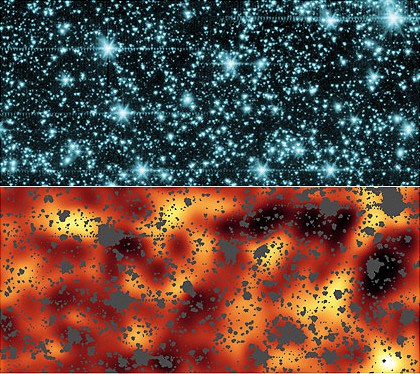Astronomers at NASA have seen signs of the first stars in the universe. Alexander Kashlinsky and colleagues at NASA's Goddard Space Flight Center in Greenbelt observed fluctuations in the cosmic infrared background which, they say, are due to "Population III" stars. The observations were made with the Spitzer Space Telescope (Nature 438 45).

Population III stars are thought to have formed in the first 200 million years after the Big Bang. Simulations predict that they were over 100 times more massive than the Sun and that they existed in clusters.
Although light from Population III stars is too weak to be detected with existing telescopes, Kashlinsky and colleagues and, independently, Asantha Cooray of the California Institute of Technology and co-workers, recently calculated that these early stars should have a left significant and measurable signal in the cosmic infrared background (CIB). However, separating out the signal from the Population III stars from all the other infrared radiation emitted by other stars and galaxies in the universe is very difficult.
Kashlinsky and colleagues used the Infrared Array Camera (IRAC) on Spitzer, which can detect wavelengths between 3.6 and 8 microns. Light from the earliest stars would have been red-shifted into this region by the expansion of the universe. When they removed infrared signals from all the other stars and galaxies in the universe, the NASA team found significant large-scale fluctuations in the infrared background.
The fluctuations were seen at four different wavelengths and at several points across the sky, which suggest that the signal is a real astrophysical effect. Moreover, the signal had not changed significantly after six months, which ruled out “zodiacal light” reflected by local interplanetary dust in our Solar System as a possible source.
“The easiest explanation of the signal is that it originates from very massive and highly clustered Population III stars,” Kashlinsky told PhysicsWeb. “This identifies for the first time the cumulative emissions produced by these, so-far hypothetical, objects.”
The team is now analysing data from observations that looked even deeper into space, and also data at larger angular scales.



